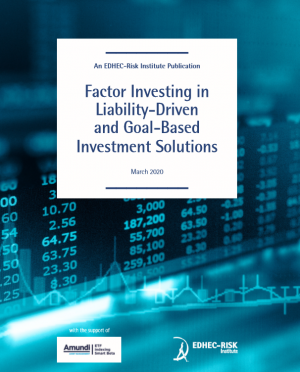
Factor Investing in Liability-Driven and Goal-Based Investment Solutions
Factor investing is a new approach for investment management where allocation decisions are expressed in terms of risk factors, as opposed to asset classes. Factor investing relies on a large body of empirical research that has evidenced the existence of factors other than the market factor to explain cross-sectional and time-series changes in expected returns. For years, a large body of empirical research has been conducted to identify the most relevant factors and associated risk premia that can be harvested in equity markets, and more recently in bond markets.
Liability-driven investing (LDI) has its foundations in the fund separation theorem of Sharpe (1964) arising in portfolio optimization problems. It follows from this theory that the optimal way for asset liability management at pension funds is to combines two distinct portfolios, one dedicated to performance and the other one dedicated to the hedging of liabilities. This approach can be shown to dominate the traditional approach based on a single portfolio that would achieve a relevant tradeoff in terms of performance and liability-risk hedging.
EDHEC has conducted a piece of research[1] that demonstrates the benefits of factor investing in the construction of both the performance-seeking and liability-hedging portfolios, and also in the optimal allocation to the two building blocks. The results of this research is of relevance for institutional investors and can be regarded as a first step towards the introduction of a comprehensive investment framework blending liability-driven and factor investing, widely recognized as the two most significant advances in institutional money management over the last two decades.
Factor investing allows an efficient diversification in the performance seeking-portfolio
From a theoretical point of view, the performance-seeking portfolio (PSP) should be determined as the portfolio that achieves the highest Sharpe ratio, i.e. the portfolio with the highest expected return per unit of risk taken. The Capital Asset Pricing Model (CAPM) introduced by Sharpe and Linter (1964, 1965) held that the portfolio made up of all existing risky assets, weighted by their market capitalisation, named the market portfolio, offered an efficient risk/return tradeoff. In other words, no other combination of risky assets makes it possible to obtain a better return for the same degree of risk, or a lower risk for the same expected return. This market portfolio has traditionally been proxied as a broad cap-weighted stock index. However, the CAPM relies on unrealistic assumptions, including the fact that all investors have identical expectations, which calls into question the efficiency of the market portfolio and their proxies. In recent years, a number of papers have provided convincing arguments that the performance-seeking portfolio should focus on efficiently harvest risk premia across and within asset classes, which is achieved by diversifying away unrewarded risk exposures. Equities is the asset class in which the concept of factor investing is the most mature, and a few factors, including size, value, momentum, volatility, investment and profitability, have been shown to lead to a robust and economically justified risk premium.
By selecting securities with the appropriate characteristics, one can construct portfolios with expected returns above the market without using active management. It is important to note, however, that this outperformance usually requires a long investment horizon to materialize, and that in the short run, significant risks of drawdown and underperformance with respect to the cap-weighted index subsist.
Construction of liability-hedging portfolios
The second building block of an LDI strategy is a liability-hedging portfolio (LHP) whose role is to replicate the performance of liabilities. Because the nature and horizon of the liabilities are specific to each investor, the LHP has to be customized to meet the needs of each investor. At this stage, factor investing will serve to identify the risk factors to which the liabilities are exposed. Those factors are generally different from those used to build the performance portfolio since the focus here is not on harvesting risk premia but on hedging liability risk exposures.
This approach is not only reserved for institutional investors, but can also be used in individual money management, where liabilities are replaced with the notion of goals, such as generating replacement income in retirement, for example. The replication of a fictitious security called the “retirement bond”, designed to provide retirees with stable replacement income for a period equal to their life expectancy in retirement without the need for annuities, is formally identical to the problem that would be faced by a defined-benefit pension fund that is committed to make fixed payments for a well-defined period. The results of the research show that the factor exposure replication strategies lead to withdrawal rates that are much closer to that of the retirement bond target, compared to the use of shorter-term bonds or money market accounts.
Choosing the optimal allocation between the performance-seeking portfolio and the liability-hedging portfolio
Finally, factor investing will also serve at the stage of allocation between the performance-seeking and the liability-hedging portfolios so as to obtain the best potential of upside performance for the liability-driven strategy, while staying within the limits of a risk budget. The performance-seeking portfolio is designed without hedging concerns, according to the fund separation theorem. However, by decreasing the tracking error of the portfolio-seeking portfolio with respect to the liabilities, an investor can allocate more to this portfolio for the same risk budget.
The present paper introduces a comprehensive factor model that can be used to analyze the overlap between the risk exposures of assets and liabilities. The model used is an eight-factor asset liability management model with the equity market factor, the long-short size, value and momentum equity factors, the ‘betting against beta’ equity factor, as well as the level of interest rates, the term spread and the credit spread. This model is shown to capture between 90% and 100% of the variance of equity factor indices, and 96.6% of that of liabilities. This factor model may serve to measure the degree of similarity between a performance-seeking portfolio and liabilities, by calculating the distance between their respective factor exposures. In particular, one can search for a performance-seeking portfolio with closer factor exposures to those of liabilities than the broad cap-weighted index, with perspectives of substantial gains over a long-term period.
Overall, this paper demonstrates that each of the three steps of a liability-driven investing process can be better addressed by taking a factor perspective, rather than the traditional policy portfolio approach.
[1] Martellini, L. and V. Milhau. 2020. Factor Investing in Liability-Driven and Goal-Based Investment Solutions. EDHEC-Risk Institute Publication. This research has benefited from the support of Amundi in the context of the «ETF and Passive Investment» EDHEC-Risk Institute’s Research Chair.



